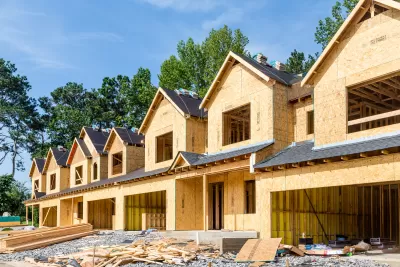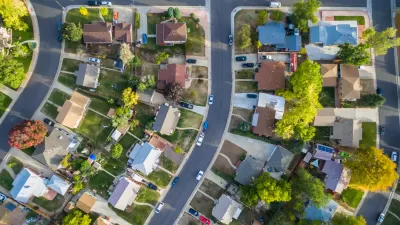If we overlook fair housing principles in the plan to build US housing back better, we risk ending up right back where we started.

The nation faces a growing housing crisis. Over the last several years, the cost of housing has skyrocketed for renters and buyers both, and housing supply has not kept up with demand. According to the U.S. Census Bureau’s 2021 American Community Survey, half of renters in the U.S. are cost burdened, spending more than 30 percent of their income on housing, while more than 30 percent are “severely cost burdened,” spending more than 50 percent, with low-income households hit hardest. Meanwhile, around 22 percent of homeowners are either moderately or severely cost burdened. “[T]hese dynamics make housing unaffordability particularly acute for Black residents, who are both less likely to own homes and more likely to be cost burdened,” according to a recent report by McKenzie Institute for Black Economic Mobility.
This problem has “plagued Americans across the country since the Great Recession—and is only getting worse,” says a report from the Kenan Institute, which estimates the United States needs four to five million more homes on the market than it has right now. But as communities across the country heed the justifiable calls to build significantly more affordable housing, there is a real risk of inadvertently perpetuating segregation and poverty by prioritizing a “build, baby, build” mentality above the principles of fair housing, which ensure that everyone has a right to choose housing free from both direct and indirect discrimination and protects their civil rights and access to economic opportunity.
Existing inequalities and inequities should not be overlooked in the extraordinary need to build more affordable housing for everyone.
Existing inequalities and inequities should not be overlooked in the extraordinary need to build more affordable housing for everyone. If this occurs, the United States will lose timely opportunities to reduce or eliminate segregation, increase economic mobility, and provide good housing for all, including groups whose life opportunities today have been constrained by historical racist practices on the part of government, the private sector, and private citizens. Fortunately, substantial and sustained community participation can help to ensure that displacement does not occur and that fair housing is not treated as an afterthought.
What is fair housing?
This month marks the 56th anniversary of the Fair Housing Act. This law is part of the 1968 Civil Rights Act signed by President Lyndon Johnson on April 11, 1968, a week after the assassination of Martin Luther King, Jr. The act had its roots in the earlier Chicago Freedom Movement, when Mayor Richard Daley, after a wave of protests and violence directed against Civil Rights activists, agreed to demands for housing and job opportunities. According to the Martin Luther King, Jr. Research and Education Institute at Stanford University, “Mayor Daley was eager to find a way to end the demonstrations. After negotiating with King and various housing boards, a summit agreement was announced in which the Chicago Housing Authority promised to build public housing with limited height requirements, and the Mortgage Bankers Association agreed to make mortgages available regardless of race. Although King called the agreement ‘the most significant program ever conceived to make open housing a reality,’ he recognized that it was only ‘the first step in a 1,000-mile journey.’”
Today, Title VIII of the Fair Housing Act prohibits discrimination based on race, color, religion, sex (including gender identity and sexual orientation), familial status, national origin, and disability. But that is not all. Numerous judicial decisions since 1968 indicate that fighting intentional discrimination is just one side of the Fair Housing Act. Equally important, the law requires federal, state, and local governments to review and respond to the social conditions, institutional practices and policies, and the behavior of private actors that maintain patterns of segregation, intentionally, or unintentionally. This is commonly referred to as “affirmatively further fair housing.”
As described in federal regulations, “Affirmatively furthering fair housing means taking proactive steps beyond simply combating discrimination to foster more inclusive communities and access to community assets for all persons protected by the Fair Housing Act. More specifically, it means taking steps proactively to address significant disparities in access to community assets, to overcome segregated living patterns and support and promote integrated communities, to end racially and ethnically concentrated areas of poverty, and to foster and maintain compliance with civil rights and fair housing laws.”
The scope of fair housing, therefore, is broad and intersectoral and calls for strategies and practices that are just as intersectional, thus “affirmatively furthering fair housing.”
Risk of overlooking fair housing lens
The many well-meaning calls for increasing housing coming from diverse sectors and all levels of government have been silent on the need to do so within the context of fair housing. However, legally, all housing policies must be contextualized with an understanding of the practices that have contributed to and continue to sustain segregation and discrimination. Not only zoning prohibitions against multifamily housing, but also lack of access to reliable public transportation, racially based real-estate steering practices, lack of investments in some neighborhoods, inaccessibility of services for people with physical challenges, site selection policies, discrimination and access to financial services like mortgages and equity loans, and private discrimination.
Unless a steadfast affirmatively furthering fair housing lens is part of the context, increasing housing supply and affordable housing by itself does not guarantee the dismantling of institutional policies or private sector practices that serve to maintain racial divisions in local housing and economic spaces.
Residential racial segregation is not only on the rise, but is shifting locations: recent research found that 81 percent of all US metros over 200,000 residents were more segregated in 2019 than in 1990. — Sharon Cornelissen and Luisa Godinez-Puig
Indeed, a recent post on Harvard’s Joint Center for Housing Studies blog by Sharon Cornelissen and Luisa Godinez-Puig suggested that having a supply-focused housing policy could hasten segregation: “Residential racial segregation is not only on the rise, but is shifting locations: recent research found that 81 percent of all US metros over 200,000 residents were more segregated in 2019 than in 1990. As gentrification and housing unaffordability price lower-income residents out of major cities, we see new racial inequalities emerging on the metropolitan fringe…unequal housing choices shape new locations of segregation across metropolitan Boston.” Further, because some groups don’t have access to certain housing markets, “… homebuying patterns are contributing to new patterns of segregation emerging between communities across the Commonwealth.”
Absent a fair housing lens, even calls for the elimination of exclusionary zoning — ironically — could have unexpected negative impacts on low-income or racial groups. The Alliance for Housing Justice warns, “Eliminating exclusionary zoning has the potential to significantly advance racial and economic justice. Unless it is done carefully, though, tackling exclusionary zoning could fail to make any real-world impacts or could have unintended consequences, including increased displacement of low-income communities of color ...”
The McKinsey report cited earlier states, “ [L]arge-scale building needs to be implemented carefully so that revitalization does not lead to displacement. Projects would need community input and fair processes for allocating new units, balancing the needs of new arrivals and current residents.”
Where do we go from here?
There is a growing acknowledgement of the need for an approach that accounts for the needs of all residents. In an article published in the Stanford Social Innovation Review, Amy Gillman and her colleagues observed that significant policy changes and practices regarding fair housing require the “centering the voices of people most affected by systemic barriers and inequities in housing.” However, that is often easier said than done. Fair housing, as a comprehensive and legal concept that crosses into many areas intersecting with housing, has been continually resisted in communities across the country. Many times the resistance is based in a fear of integration and diversity. But the U.S. Supreme Court has a strong record of endorsing affirmatively furthering fair housing as comprehensive and multi-layered in its application.
With this in mind, a recent report led by Dr. James Jennings (coauthor of this article), Advancing Fair Housing in Greater Boston, Massachusetts: Voices from the Field, surveyed 36 community and civic leaders across Massachusetts about what they see as challenges to fair housing, and that may be relevant for other places.
Study participants highlighted five major challenges facing the state of fair housing in Massachusetts cities and towns:
- Limited public and community-based awareness about the scope of Fair Housing.
- Lack of ample resources for implementing, monitoring, and enforcing Fair Housing.
- Absence of attention or actions to address the impacts of historical racial discrimination, or racial discrimination today, in many cities and towns.
- Lack of stronger emphasis on accessible, equitable, and efficient public transportation as critical for advancing fair housing in suburban communities;
- A disconnect between growing calls to increase housing supply, and even affordable housing, with an “affirmatively furthering fair housing” lens.
These challenges probably resonate in many communities across the nation. And while the solutions in greater Boston might not completely apply to other communities, what is universal — based on the views of a range of civic and community leaders throughout Massachusetts — is the need to organize community residents and make them aware of how a fair housing lens represents a crucial tool for social, economic, and housing equity. “Community organizing creates opportunities for residents to connect with systems of power and enact change,” says a research guide from the Urban Institute.
Fortunately, a growing number of resources are available to help planning and housing agencies engage with their communities and to implement a fair housing lens. HUD, which requires substantial community participation in its housing programs and design, has created a Fair Housing Tool Kit. The Urban Institute research guide quoted above includes a wealth of tools and resources. The Local Housing Solutions initiative based at the NYU Furman Center provides a toolkit for engaging community participation in substantive ways.
The Jennings, et al., study proposes that community organizing can be facilitated by organizing residents and allies around a series of broad and critical queries pertaining to their localities. Some of queries these include:
- What explains the history and current low rates of Black and Latino/a homeownership?
- How can zoning be used to enhance fair housing? How does zoning and public transportation limit multifamily housing, and how does it impact on various groups of people?
- Is the municipality and or state leadership working actively with financial sectors to reduce discrimination and assist in increasing homeownership rates adequate housing for protected classes?
- What is the extent and quality of outreach to people of color and low-income groups about housing opportunities? How are immigrants and persons with limited English-speaking ability approached in terms of raising awareness about fair housing regulations?
Conclusion
Only strong and sustained community organizing can ensure that calls for “build, baby, build” do not overshadow fair housing. There is a critical need to organize community residents and make them aware of how a fair housing lens represents a crucial tool for social, economic, and housing equity in the midst of building more affordable housing. Progressive local community activists should push their city and state representatives to become ‘bully pulpits’ for expanding civic dialogues about increasing the supply of affordable housing and fair housing. Municipalities should engage public and private higher education, and foundations in facilitating community participation about fair housing and community development and implications not just for housing, but also transportation, public health, education, and impacts on segregation and poverty.
We cannot let fair housing be placed on the back burner or become an afterthought in responding to the nation’s housing crisis.
We cannot let fair housing be placed on the back burner or become an afterthought in responding to the nation’s housing crisis. Without a fair housing lens, the call to “build, baby, build” will overshadow important questions about where we build, how we build, who we hire to build, what we build, and for whom we build. The Fair Housing Act and its ‘affirmatively furthering fair housing’ requirement can assist in ensuring the where, how, what, and who the beneficiaries of “build baby build” are will not contribute to continuing segregation, locally or nationally.
James Jennings is professor emeritus of urban and environmental policy and planning at Tufts University. Lydia Edwards is a Massachusetts state senator and is also a former Boston city councilor, where she successfully led the city’s adoption of fair housing requirements in its zoning codes.

Alabama: Trump Terminates Settlements for Black Communities Harmed By Raw Sewage
Trump deemed the landmark civil rights agreement “illegal DEI and environmental justice policy.”

Planetizen Federal Action Tracker
A weekly monitor of how Trump’s orders and actions are impacting planners and planning in America.

The 120 Year Old Tiny Home Villages That Sheltered San Francisco’s Earthquake Refugees
More than a century ago, San Francisco mobilized to house thousands of residents displaced by the 1906 earthquake. Could their strategy offer a model for the present?

Opinion: California’s SB 79 Would Improve Housing Affordability and Transit Access
A proposed bill would legalize transit-oriented development statewide.

Record Temperatures Prompt Push for Environmental Justice Bills
Nevada legislators are proposing laws that would mandate heat mitigation measures to protect residents from the impacts of extreme heat.

Downtown Pittsburgh Set to Gain 1,300 New Housing Units
Pittsburgh’s office buildings, many of which date back to the early 20th century, are prime candidates for conversion to housing.
Urban Design for Planners 1: Software Tools
This six-course series explores essential urban design concepts using open source software and equips planners with the tools they need to participate fully in the urban design process.
Planning for Universal Design
Learn the tools for implementing Universal Design in planning regulations.
Clanton & Associates, Inc.
Jessamine County Fiscal Court
Institute for Housing and Urban Development Studies (IHS)
City of Grandview
Harvard GSD Executive Education
Toledo-Lucas County Plan Commissions
Salt Lake City
NYU Wagner Graduate School of Public Service





























